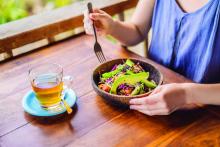User login
A . After 16 weeks, the mean Disease Activity Score in 28 joints (DAS28) decreased from 4.5 to 2.5 (P < .001), and the mean number of swollen joints dipped from 7.0 to 3.3 (P = .03).
The study was published in the American Journal of Lifestyle Medicine. It’s not clear whether the vegan diet or the restriction of trigger foods – or both or neither – was helpful. Significant weight loss in the diet group could have played a role in reducing symptoms.
Still, the dietary strategy is “a life-changing experience for people,” lead author Neal D. Barnard, MD, an internal medicine specialist and adjunct professor of medicine at George Washington University, Washington, D.C, and president of the Physicians Committee for Responsible Medicine, said in an interview. “Doctors should know about it, and they should try it themselves.”
The researchers launched the study to determine the feasibility of a “practical and easy-to-prescribe diet” without caloric limits, Dr. Barnard said. “People have done a variety of studies where they’ve looked at diet changes, often with fasting, and the quality has been variable.”
There’s no consensus in the medical literature on which dietary approach is best for patients with RA. A 2021 systematic review by Philippa and colleagues found positive results for the Mediterranean diet, high doses of omega-3 fatty acids, vitamin D supplementation, and sodium restriction. Fasting had significant but temporary effects, and the reviewers noted “outcomes from vegetarian, elimination, peptide, or elemental diets suggested that responses are very individualized.”
For the new randomized, crossover study, researchers assigned 44 women to one of two diet phases. After 16 weeks, they had a 4-week washout period, then began the other 16-week phase. A total of 32 patients completed the study, and they had a mean age of 57 years. Overall, 66% were White, 16% were Black, and 79% held a college degree or graduate degree.
In the 16-week intervention phase, participants went on a low-fat vegan diet. After 4 weeks, they eliminated common RA trigger foods such as grains with gluten, nuts, citrus fruits, and chocolate. After week 7, the subjects added back the trigger foods one by one, keeping them in their diet if they didn’t seem to cause pain.
In the 16-week placebo phase, the women took a supplement that they were told contained omega-3 oils and vitamin E. However, the amounts of omega-3 and vitamin E were very low and had no apparent effect.
Participants in the diet phase attended weekly 1-hour dietary support-group sessions. Thirty-two women completed the full study.
Average DAS28 scores fell in the diet phase, compared with the supplement phase (treatment effect, 1.8 [95% confidence interval [CI], 3.2 to 0.4]; P = .01), as did swollen joints (treatment effect, –4.2 [95% CI, –8.3 to –0.1], P = .047).
While the researchers reported dips in the DAS28 score and swollen joints, “the reductions in the number of painful and tender joints did not reach statistical significance (treatment effects, –4.1 [95% CI, –8.7 to +0.5]; P = .08; and –1.8 [95% CI, –5.5 to +1.9]; P = .41, respectively).”
Mean body weight fell by 6.5 kg among those in the diet group, while those in the placebo group gained 0.8 kg (treatment effect, –7.3 kg [95% CI, –9.4 to –5.1]; P < .001).
The researchers noted “the presumed mechanisms by which diets such [as this intervention strategy] reduce joint symptoms relate to the removal of inflammatory elements of an omnivorous diet, the presence of anti-inflammatory constituents in a plant-based diet, and diet-induced reductions in gut permeability that may, in turn, reduce the passage of antigens into circulation.”
Patients tolerate the diet well, Dr. Barnard said. “It’s practical for day-to-day life, and you don’t have to check into a fasting hospital.”
The message for physicians, he said, is to encourage patients to try changing their eating patterns before turning to medication. “It’s a good idea for anyone to have a chance to try a diet change,” he said. “You’ll know within a matter of weeks whether it will work.”
Vegan diets are also cheaper than diets with meat and dairy, he added.
The study has various limitations. It began with 44 participants, but 12 failed to complete it for various reasons. Four participants who were assigned to the diet phase first refused to resume their regular diets during the next phase. It’s not clear if the lost weight is most responsible for the diet’s benefits, Harvard Medical School rheumatologist Daniel H. Solomon, MD, MPH, said in an interview. In his review of the study findings, Dr. Solomon said that another possibility is that certain aspects of the diet – and not the full diet – were responsible.
“I am sure that motivated patients could follow such a diet,” he said, “but first we should determine if the specific diet was the key issue or whether weight loss was more important.”
The study was funded by the Physicians Committee for Responsible Medicine. Dr. Barnard disclosed royalties and honoraria from books, articles, and lectures on nutrition and health.
A . After 16 weeks, the mean Disease Activity Score in 28 joints (DAS28) decreased from 4.5 to 2.5 (P < .001), and the mean number of swollen joints dipped from 7.0 to 3.3 (P = .03).
The study was published in the American Journal of Lifestyle Medicine. It’s not clear whether the vegan diet or the restriction of trigger foods – or both or neither – was helpful. Significant weight loss in the diet group could have played a role in reducing symptoms.
Still, the dietary strategy is “a life-changing experience for people,” lead author Neal D. Barnard, MD, an internal medicine specialist and adjunct professor of medicine at George Washington University, Washington, D.C, and president of the Physicians Committee for Responsible Medicine, said in an interview. “Doctors should know about it, and they should try it themselves.”
The researchers launched the study to determine the feasibility of a “practical and easy-to-prescribe diet” without caloric limits, Dr. Barnard said. “People have done a variety of studies where they’ve looked at diet changes, often with fasting, and the quality has been variable.”
There’s no consensus in the medical literature on which dietary approach is best for patients with RA. A 2021 systematic review by Philippa and colleagues found positive results for the Mediterranean diet, high doses of omega-3 fatty acids, vitamin D supplementation, and sodium restriction. Fasting had significant but temporary effects, and the reviewers noted “outcomes from vegetarian, elimination, peptide, or elemental diets suggested that responses are very individualized.”
For the new randomized, crossover study, researchers assigned 44 women to one of two diet phases. After 16 weeks, they had a 4-week washout period, then began the other 16-week phase. A total of 32 patients completed the study, and they had a mean age of 57 years. Overall, 66% were White, 16% were Black, and 79% held a college degree or graduate degree.
In the 16-week intervention phase, participants went on a low-fat vegan diet. After 4 weeks, they eliminated common RA trigger foods such as grains with gluten, nuts, citrus fruits, and chocolate. After week 7, the subjects added back the trigger foods one by one, keeping them in their diet if they didn’t seem to cause pain.
In the 16-week placebo phase, the women took a supplement that they were told contained omega-3 oils and vitamin E. However, the amounts of omega-3 and vitamin E were very low and had no apparent effect.
Participants in the diet phase attended weekly 1-hour dietary support-group sessions. Thirty-two women completed the full study.
Average DAS28 scores fell in the diet phase, compared with the supplement phase (treatment effect, 1.8 [95% confidence interval [CI], 3.2 to 0.4]; P = .01), as did swollen joints (treatment effect, –4.2 [95% CI, –8.3 to –0.1], P = .047).
While the researchers reported dips in the DAS28 score and swollen joints, “the reductions in the number of painful and tender joints did not reach statistical significance (treatment effects, –4.1 [95% CI, –8.7 to +0.5]; P = .08; and –1.8 [95% CI, –5.5 to +1.9]; P = .41, respectively).”
Mean body weight fell by 6.5 kg among those in the diet group, while those in the placebo group gained 0.8 kg (treatment effect, –7.3 kg [95% CI, –9.4 to –5.1]; P < .001).
The researchers noted “the presumed mechanisms by which diets such [as this intervention strategy] reduce joint symptoms relate to the removal of inflammatory elements of an omnivorous diet, the presence of anti-inflammatory constituents in a plant-based diet, and diet-induced reductions in gut permeability that may, in turn, reduce the passage of antigens into circulation.”
Patients tolerate the diet well, Dr. Barnard said. “It’s practical for day-to-day life, and you don’t have to check into a fasting hospital.”
The message for physicians, he said, is to encourage patients to try changing their eating patterns before turning to medication. “It’s a good idea for anyone to have a chance to try a diet change,” he said. “You’ll know within a matter of weeks whether it will work.”
Vegan diets are also cheaper than diets with meat and dairy, he added.
The study has various limitations. It began with 44 participants, but 12 failed to complete it for various reasons. Four participants who were assigned to the diet phase first refused to resume their regular diets during the next phase. It’s not clear if the lost weight is most responsible for the diet’s benefits, Harvard Medical School rheumatologist Daniel H. Solomon, MD, MPH, said in an interview. In his review of the study findings, Dr. Solomon said that another possibility is that certain aspects of the diet – and not the full diet – were responsible.
“I am sure that motivated patients could follow such a diet,” he said, “but first we should determine if the specific diet was the key issue or whether weight loss was more important.”
The study was funded by the Physicians Committee for Responsible Medicine. Dr. Barnard disclosed royalties and honoraria from books, articles, and lectures on nutrition and health.
A . After 16 weeks, the mean Disease Activity Score in 28 joints (DAS28) decreased from 4.5 to 2.5 (P < .001), and the mean number of swollen joints dipped from 7.0 to 3.3 (P = .03).
The study was published in the American Journal of Lifestyle Medicine. It’s not clear whether the vegan diet or the restriction of trigger foods – or both or neither – was helpful. Significant weight loss in the diet group could have played a role in reducing symptoms.
Still, the dietary strategy is “a life-changing experience for people,” lead author Neal D. Barnard, MD, an internal medicine specialist and adjunct professor of medicine at George Washington University, Washington, D.C, and president of the Physicians Committee for Responsible Medicine, said in an interview. “Doctors should know about it, and they should try it themselves.”
The researchers launched the study to determine the feasibility of a “practical and easy-to-prescribe diet” without caloric limits, Dr. Barnard said. “People have done a variety of studies where they’ve looked at diet changes, often with fasting, and the quality has been variable.”
There’s no consensus in the medical literature on which dietary approach is best for patients with RA. A 2021 systematic review by Philippa and colleagues found positive results for the Mediterranean diet, high doses of omega-3 fatty acids, vitamin D supplementation, and sodium restriction. Fasting had significant but temporary effects, and the reviewers noted “outcomes from vegetarian, elimination, peptide, or elemental diets suggested that responses are very individualized.”
For the new randomized, crossover study, researchers assigned 44 women to one of two diet phases. After 16 weeks, they had a 4-week washout period, then began the other 16-week phase. A total of 32 patients completed the study, and they had a mean age of 57 years. Overall, 66% were White, 16% were Black, and 79% held a college degree or graduate degree.
In the 16-week intervention phase, participants went on a low-fat vegan diet. After 4 weeks, they eliminated common RA trigger foods such as grains with gluten, nuts, citrus fruits, and chocolate. After week 7, the subjects added back the trigger foods one by one, keeping them in their diet if they didn’t seem to cause pain.
In the 16-week placebo phase, the women took a supplement that they were told contained omega-3 oils and vitamin E. However, the amounts of omega-3 and vitamin E were very low and had no apparent effect.
Participants in the diet phase attended weekly 1-hour dietary support-group sessions. Thirty-two women completed the full study.
Average DAS28 scores fell in the diet phase, compared with the supplement phase (treatment effect, 1.8 [95% confidence interval [CI], 3.2 to 0.4]; P = .01), as did swollen joints (treatment effect, –4.2 [95% CI, –8.3 to –0.1], P = .047).
While the researchers reported dips in the DAS28 score and swollen joints, “the reductions in the number of painful and tender joints did not reach statistical significance (treatment effects, –4.1 [95% CI, –8.7 to +0.5]; P = .08; and –1.8 [95% CI, –5.5 to +1.9]; P = .41, respectively).”
Mean body weight fell by 6.5 kg among those in the diet group, while those in the placebo group gained 0.8 kg (treatment effect, –7.3 kg [95% CI, –9.4 to –5.1]; P < .001).
The researchers noted “the presumed mechanisms by which diets such [as this intervention strategy] reduce joint symptoms relate to the removal of inflammatory elements of an omnivorous diet, the presence of anti-inflammatory constituents in a plant-based diet, and diet-induced reductions in gut permeability that may, in turn, reduce the passage of antigens into circulation.”
Patients tolerate the diet well, Dr. Barnard said. “It’s practical for day-to-day life, and you don’t have to check into a fasting hospital.”
The message for physicians, he said, is to encourage patients to try changing their eating patterns before turning to medication. “It’s a good idea for anyone to have a chance to try a diet change,” he said. “You’ll know within a matter of weeks whether it will work.”
Vegan diets are also cheaper than diets with meat and dairy, he added.
The study has various limitations. It began with 44 participants, but 12 failed to complete it for various reasons. Four participants who were assigned to the diet phase first refused to resume their regular diets during the next phase. It’s not clear if the lost weight is most responsible for the diet’s benefits, Harvard Medical School rheumatologist Daniel H. Solomon, MD, MPH, said in an interview. In his review of the study findings, Dr. Solomon said that another possibility is that certain aspects of the diet – and not the full diet – were responsible.
“I am sure that motivated patients could follow such a diet,” he said, “but first we should determine if the specific diet was the key issue or whether weight loss was more important.”
The study was funded by the Physicians Committee for Responsible Medicine. Dr. Barnard disclosed royalties and honoraria from books, articles, and lectures on nutrition and health.
FROM THE AMERICAN JOURNAL OF LIFESTYLE MEDICINE



